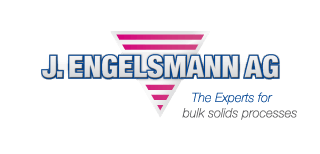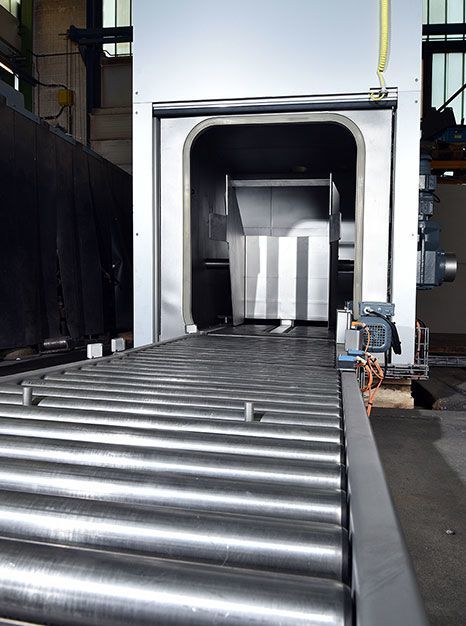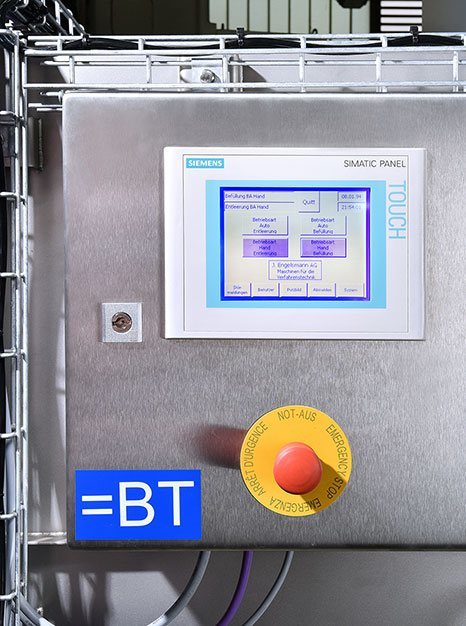14.05.2015
Fully automated drum emptying and screening of fragile catalysts
Special equipment manufacturing needs intelligent solutions, as a new project from the bulk solids specialist J. Engelsmann AG demonstrates. A chemical producer was using manual handling – muscle power – for emptying drums in the production of fragile catalysts. The significant investment required to meet strict health and safety regulations coupled with insufficient capacity led the customer to consider a new and more productive solution.
Companies in the chemical industry usually handle hazardous substances in drums and octabins. Emptying the drums is a physically demanding and often dangerous process because products can be both toxic and irritants. Another problem with emptying containers by hand, quite apart from the strict safety and hygiene requirements to be met, is emptying the drums completely without using discharge or extraction systems. In this case, the production process involved removing extremely fragile granulate catalysts from drums as carefully as possible for further processing, and sifting out damaged material. To date, the drums delivered to the customer had been emptied manually by two members of staff using lifting equipment. Extensive measures had to be taken to protect personnel as the catalyst product is not just highly porous but also very dusty with a strong odor. Handling in an open area exposed the operating staff to hazardous substances, as escaping dust contaminated the atmosphere during the emptying process.
Another problem was productivity: manual loading prevented even input to the downstream calcination process, and there was not sufficient capacity.
Fully-automatic drum emptying improves productivity and working conditions
It soon became clear that to increase productivity, the manual process would have to be automated. The plant supplier was also to offer a turnkey solution covering all services from design and manufacture to machine installation and commissioning, in order to minimize interfaces and coordination work. Product tests were run under real operating conditions at the Engelsmann pilot plant to simulate the operating processes, and the customer was impressed with the solution designed. Successful testing was followed by basic engineering and plant layout design.
The Engelsmann design engineers created a fully automatic plant that could empty drums containing the hazardous catalyst product inside an enclosure and without creating dust. The solution was designed to offer maximum operator safety, fully empty a much higher number of drums, and feed the product straight into a downstream screening unit to remove damaged material. As the catalyst is delivered to the emptying station in drums, with four drums to a pallet, the risk of damage cannot be ruled out – prior filling and loading makes this impossible. However, to ensure that emptying the drums does not cause further damage, the entire drum emptying plant is designed for careful product handling.
Priority: protecting personnel and the product
The plant has a fully automatic roller conveyor. Operating personnel open the drums, which are then transported to the front of the drum emptying enclosure with the help of a lifting gear. A maximum of 3 drums fit on the accumulating conveyor at any one time. There is also a drum stop when activated, this ensures that the emptying plant intermittent conveyor only moves one drum to the tilt stop in the enclosure. The enclosure has a pneumatic lifting door with an inflatable seal; the seal deflates after the emptying process starts so that the door can then open. A roller conveyor in the enclosure moves the drum to the drum holder. The enclosure door then closes and the inflatable door seal automatically inflates. The drum holder basket slowly moves the drum into the emptying position. The tilt angle is set to empty out the product slowly and carefully. Underneath is a guide plate that catches the material pouring out of the drum and directs it onto the slanting side of a buffer container. The catalyst material runs down along down the side of the container, and therefore does not hit the bottom with its full weight. Once a layer of material has built up in the bottom of the container, this cushions the subsequent flow. The buffer container can hold the contents of four drums containing 200 kg of material each – in other words one pallet load. A drum that has been completely emptied is automatically returned to its starting position. The operating personnel then activate deflation of the inflatable enclosure door seal and the door opens. The roller conveyor returns the empty drum to the intermittent conveyor in front of the enclosure, where it is removed by a member of staff. A new emptying process can now be started – and will run completely automatically. The plant controls communicate with the site process controls over an interface; the customer’s dust extraction system provides the plant aspiration function. A vacuum valve in the drum emptying enclosure sucks ambient air into the dusty area of the enclosure where it extracts the product dust and sucks it towards the aspiration outlet.
Damaged material: screened as if by hand
Once the emptying process is complete, a dosing channel at the drum emptying plant discharge transfers the sensitive catalyst material to a long-stroke screening machine – also supplied and manufactured by Engelsmann. The screening machine’s horizontal swing guarantees precise and gentle sieving, and the removal of almost 100 percent of damaged material (fine material). The damaged material removed is not processed further; it is fed back into the original process. The undamaged catalyst material is transported straight to a site calcination kiln for calcination. The single-deck long-stroke screening machine has a sieving area of 0.36 m² and two discharges, one for coarse and one for fine material. As the plant is designed to meet a higher capacity than is currently required, throughput can easily be increased if and when needed. A final Factory Acceptance Test (FAT) was carried out on the plant at the Engelsmann site following engineering and manufacture of the plant components, and after a four-month delivery/construction phase, the Engelsmann engineers were able to install and commission the plant four weeks before the scheduled delivery date. Fully automatic drum emptying solved multiple problems for the customer: productivity increased by more than 25%, and the gentle emptying and screening process minimized damage and therefore significantly improved product quality.
The low residual dust levels in the air from the emptying process have also minimized the health risk for operating personnel, considerably improving working conditions – and reducing the costs of health and safety precautions.








